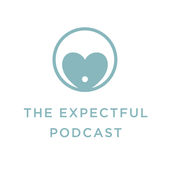
How To Love Your Birth – The Expectful Podcast
Why this podcast?
I had heard about Expectful pretty often whilst listening to podcasts. I knew that they offered guided meditation for fertility, pregnancy and motherhood but had not realised there was also a podcast!
Once I subscribed there was an episode that grabbed my attention immediately.
The host, Anna Gannon, is a new mum, yoga teacher, Expectful’s community guide and writer. She says that the guided meditations she used during a difficult time in her pregnancy helped her so much that she wanted to join the team.
Anna wanted to share the conversations she’d had with both pre and postnatal experts as well as hundreds of listeners in order to help us live our best life.
These conversations range from –
“relationships, to body image to what it means to feel emotionally and physically supported”

How does it look?
The Expectful Podcast started broadcasting in July 2017 and there are just over thirty episodes to date. Episodes tend to be in the thirty-five to forty-five-minute range and have covered such topics as how to feel empowered during birth, how to trust yourself as a parent, sex and healing after birth, pregnancy loss and grief, fitness, hormones, health and your period, boosting sleep and home birth.
Why this episode?
The idea of being able to love your birth, however, it looks and whatever turns it takes instantly appealed to me but, at the same time, I was sceptical.
There are women who have truly traumatic births. How can they love their experiences?
If it is possible though, how wonderfully healing could that be? I knew I had to listen to this one.
Who should listen to this episode?
Anyone who is expecting a baby.

The episode
The guest on this episode is nurse turned midwife Anne Margolis. Anne has delivered over a thousand babies and certainly knows a thing or two about birth.
She begins by sharing the story of her own first birth. As a nurse, she says she was given the “royal treatment” but this still meant lying in a bed, not allowed to eat or drink.
She describes being able to hear the medical staff talking about her and the fact that she wasn’t dilating fast enough.
Anne was super active, a dancer, and had a huge fear of having a cesarean. Pitocin was started to increase the strength of her contractions and the infamous cascade of interventions began.
The pitocin contractions came much harder and faster than natural ones would have and Anne found them hard to handle. She opted for an epidural which in turn sent her baby’s heart rate plummeting. Cue Anne’s worst fear – she was taken in for an emergency cesarean.
She describes being left alone in the operating room for an hour. During that time she became convinced that her baby was either seriously damaged or had died.
Amazingly, the epidural relaxed Anne enough that she could let go and allow her body to dilate completely. At the end of that hour, she started to push. In rushed the doctor, cut a huge episiotomy and used a vent house suction cup to pull Anne’s baby out.
Her baby seemed fine and so Anne was expected to be too.

Repeat trauma
A couple of years later, still working on the same unit, Anne was pregnant again. At this point, she began to share her frustrations about the treatment women were receiving.
In labour, Anne experienced a lot of fear and describes one of the doctors, a colleague, walking into the room, putting his hand inside her to check dilation and then leaving again. All without saying a word.
Respectful care? I don’t think so.
Anne heard him walk down the corridor and say
“baby’s high and posterior, she’s never going to do this, prep the O.R.”
More confident this time, Anne called him back and said no, I don’t want a cesarean. The doctor was able to turn the baby and Anne had a vaginal birth.
After this second traumatic experience, Anne spoke to a friend who told her she was training to be a midwife.
Anne’s response?
“What’s that?”
Long story short, Anne trained as a midwife and never looked back.
Wanting to test out the midwifery model of care Anne’s third birth was natural.
No epidural. No intervention.
Her midwife simply held the space for Anne’s body to do what it knew how to do.
It was, Anne says, tough, but “I rocked it. I found my strength”.
And I just love that.
Anne talks about women in labour being at once at their most vulnerable and their most powerful and I believe that so completely.

What’s the most important thing a midwife can do at a birth? Knit
Anne shares this famous piece of advice from the wonderful Michel Odent. She expands on it by saying that once she became a midwife, she had to lose the nurse part of herself.
She had to learn how to sit calmly, observe and encourage but not intervene. Learning to see birth as normal and safe unless proven otherwise rather than vice versa was a huge learning curve.
Mostly, Anne says, to allow women to birth smoothly and safely, care providers just need to “get out of the way”.
So, we know what midwives can do, what about mothers?
Anne talks about how important it is for modern women to get back in touch with the instinctual, the primitive part of their brain. This is the part you need in labour.
How can you do this?
Dance, yoga, meditation. Recognise any fear you may have, accept it and then move on.
Anne talks about the fact that mediation can be as simple as sitting for ten, fifteen, maybe twenty minutes a day and just focusing on your breath.
She goes into her experience with Clarity Breath Work to release trauma. She credits it with saving her life and knows way more about it than I do so I’ll let you listen to Anne share more about that in the episode.

A fortress of positivity
Anne has created a course entitled Love Your Birth that covers pregnancy, birth, breastfeeding, the postpartum period and so much more.
She takes women through how to deal with their fears, how they can reclaim their confidence, trust the process of birth and bring joy to it.
She talks about choosing not to invite the negative stories in and, instead, to create a “fortress of positivity“.
Through this course, you can learn about all the tests and procedures that you will most likely encounter so you know the risks and benefits of each and how you feel about accepting them or not.
Meditation, visualisation and breath work for labour also feature as well as ways your partner can support you and how to prepare your mindset for reaching your birth goals. Just as a runner cannot complete a marathon if they do not know, in their own mind, that they can do it, a woman needs to have a similar, strong mindset to give birth.

Anne underlines that much of the course is dedicated to helping a woman understand that –
“She knows how to do this. She has the strength. She is a goddess. She is a warrior…she knows what she has to face and she can rock it and she can celebrate it.”
Yes! Just, yes!
Women need more of this and less being told that they can’t. That their bodies are not working properly. That they’re broken and need doctors to fix them. Of course, there are times that things go awry and in those situations, thank goodness for doctors and medicine but most of the time? See above!!!

To wrap up
Although I loved the contagious enthusiasm of Anne Margolis and the wisdom she carries, I was a bit disappointed that very little of this episode covered, in a specific way, how to love your birth, no matter how it looks.
Having said that, I love that the host simply allows the guest to talk and the narrative to flow so seamlessly. I also find the array of episodes really inspiring and am definitely going to listen to more.
If you have taken this course I would love to hear from you and if you are interested in taking it you can use this link to explore the content in more detail and the code EXPECTFUL for a twenty-five percent discount.
Let me know if you decide to sign up!
Emily Wills is a doula based in Stockholm. She believes that birth can be a beautiful and empowering experience and started this blog as a way of sharing some really great podcasts. She is also a mother of three and an enthusiastic runner.
